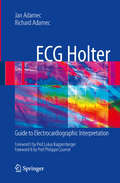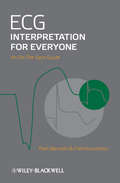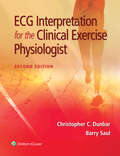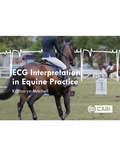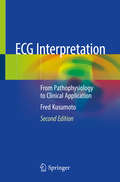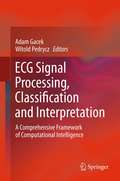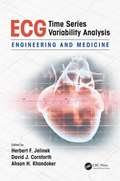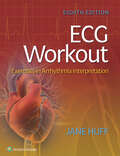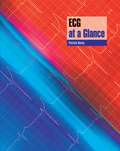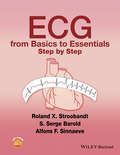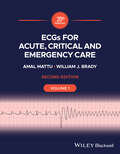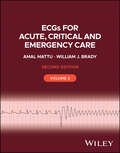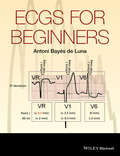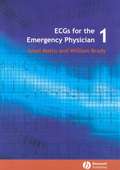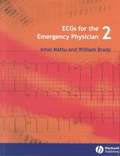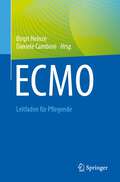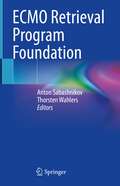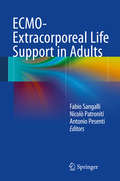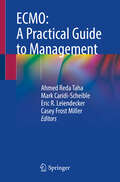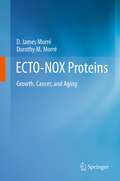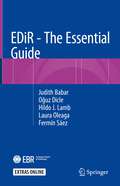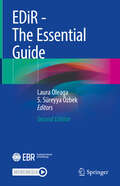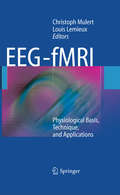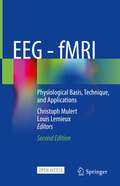- Table View
- List View
ECG Holter
by Lukas Kappenberger Jan Adamec Richard Adamec Philippe CoumelTwenty-four hour ECG recordings continue to be the backbone of electrocardiographic diagnosis. The devices are worn by patients on an outpatient basis for days or weeks and can also be implanted subcutaneously. ECG Holter recordings not only detect rhythmic and subjective events but can also be programmed individually for activation and specific tracing analysis. The purpose of this volume is to provide an overview of the techniques, interpretation, advantages and disadvantages of ECG Holter monitoring.
ECG Interpretation Made Incredibly Easy! (Incredibly Easy! Series®)
by Jessica S. CovielloDrop the ECG anxiety and learn to interpret rhythm strips in simple, stress-free ways, with the popular ECG Interpretation Made Incredibly Easy!®, 7th Edition. Offering expert direction, this freshly updated, fully illustrated guide is packed with images and learning aids that support your understanding and retention in obtaining and interpreting rhythm strips. Recognize and treat a wide variety of arrhythmias with this vital text — an ideal study aid and friendly on-the-unit support for both students and practicing nurses.
ECG Interpretation for Everyone
by Fred Kusumoto Pam BernathThis is a book for any care provider - from advanced students and nurses to residents and even specialists - who needs to master the interpretation of ECGs, especially while "on the spot" at the point of care. This easy-to-use, visual guide takes a novel approach, foregrounding the visual clues or "keys" that readers can learn to recognize in ECGs and thus make rapid decisions about next steps at the point of care. The comparatively minimal text focuses on "must-know" information about the underlying cause of ECG abnormalities.
ECG Interpretation for the Clinical Exercise Physiologist
by Christopher Dunbar Barry SaulWritten specifically for clinical exercise physiologists, ECG Interpretation for the Clinical Exercise Physiologist, 2nd Edition, provides an introduction to basic concepts and measurements followed by in-depth explorations of rhythm and atrioventricular blocks and key topics including infarct, hypertrophy, axis, and conduction defects. Accompanying exercise-related case studies make this engaging text an ideal review resource for certification prep as well as a guide to success in practice. Enhancements to this 2nd Edition include a new design that improves readability and clarity, expanded study support through updated examples and case study questions, as well as additional interpretation practice opportunities that ensure understanding and boost clinical confidence.
ECG Interpretation in Equine Practice
by Katharyn MitchellAdvances in veterinary medical technology now provide easier and more affordable access to equine ECG recording and transmitting equipment, making ECG recordings a useful tool for equine veterinarians in both field and hospital settings. Covering the basics of equine ECG recording, analyses and interpretation, this book provides a practical approach with details of how to get the most information out of your ECG recordings. The only book dedicated to equine ECGs, it includes: - Numerous clear ECG illustrations - Worked case examples to put theory into practice - New pharmacological therapies and interventional techniques A hands-on guide for veterinarians to use when recording, diagnosing and treating arrhythmias in horses, this book will be invaluable to both specialists and those who find themselves evaluating the occasional equine patient.
ECG Interpretation: From Pathophysiology to Clinical Application
by Fred KusumotoThe second edition of this book provides an overview of electrocardiography from a pathophysiological basis. Refreshed with color illustrations, it incorporates new anatomic and electrophysiologic information as well as updated material on clinical applications of the electrocardiogram (ECG). Intended as a reference for students with a basic understanding of the ECG, the book’s focus is to provide the fundamental anatomic and electrophysiologic processes that lead to ECG changes rather than simple pattern recognition. Each chapter has key points and questions with comprehensive explanations so that the reader can assess their understanding of the contents. It can be utilized as a guide – chapter by chapter – or read cover to cover for a complete overview. Case studies are included at the end of the book that integrate the multiple principles of electrocardiography. The Second Edition of ECG Interpretation: From Pathophysiology to Clinical Application is an essential text for medical students, residents, fellows, physicians, and nurses in cardiology and clinical cardiac electrophysiology.
ECG Signal Processing, Classification and Interpretation
by Adam Gacek Witold PedryczThe book shows how the various paradigms of computational intelligence, employed either singly or in combination, can produce an effective structure for obtaining often vital information from ECG signals. The text is self-contained, addressing concepts, methodology, algorithms, and case studies and applications, providing the reader with the necessary background augmented with step-by-step explanation of the more advanced concepts. It is structured in three parts: Part I covers the fundamental ideas of computational intelligence together with the relevant principles of data acquisition, morphology and use in diagnosis; Part II deals with techniques and models of computational intelligence that are suitable for signal processing; and Part III details ECG system-diagnostic interpretation and knowledge acquisition architectures. Illustrative material includes: brief numerical experiments; detailed schemes, exercises and more advanced problems.
ECG Time Series Variability Analysis: Engineering and Medicine
by Herbert F. Jelinek David J. Cornforth Ahsan H. KhandokerDivided roughly into two sections, this book provides a brief history of the development of ECG along with heart rate variability (HRV) algorithms and the engineering innovations over the last decade in this area. It reviews clinical research, presents an overview of the clinical field, and the importance of heart rate variability in diagnosis. The book then discusses the use of particular ECG and HRV algorithms in the context of clinical applications.
ECG Workout: Exercises in Arrhythmia Interpretation
by Jane HuffImprove your ability to provide reliably accurate rhythm strip interpretation with the newly updated, fully interactive ECG Workout, 8th Edition. Written by an expert arrhythmia instructor, this definitive guide to electrocardiography basics identifies and explains the many types of arrhythmias seen in nursing practice, and describes the various rhythm groups, forms of equipment, and treatment protocols. A proven guide to ECG tracing interpretation methods, the text offers crucial support to nursing students; nurses practicing in cardiac care, critical care, or trauma settings; and those preparing for advanced cardiac life support (ACLS) certification.
ECG at a Glance (At a Glance)
by Patrick DaveyHighly Commended in the Cardiology category at the British Medical Association Book Awards 2009 This brand new title in the popular at a Glance seriescombines the science behind ECGs with how to use them to guide diagnosis and treatment. These key skills are fundamental for examination of the cardiovascular system and all medical students and specialist nurses are expected to be proficient at ECG interpretation. The at a Glance approach provides a large number of clear diagrams and example ECGs alongside concise text, putting the ECGs into a clinical context, all in easy-to-absorb double-page sections.
ECG from Basics to Essentials
by Roland X. Stroobandt Alfons F. Sinnaeve S. Serge BaroldThis brand new guide assists students, interns and residents in developing a functional understanding of the set-up, workings and interpretation of ECGs Step-by-step graphics and short, bite-sized explanations Covers all major cardiac abnormalities including hypertrophy, arrhythmias, conduction blocks, and pre-excitation syndromes Begins with a section on physiology of the heart and the basic set up of ECG recording Features top tips on what to look for, complete with illustrated examples Supported by a companion website featuring additional practice tracings
ECGs for Acute, Critical and Emergency Care, Volume 1, 20th Anniversary
by William J. Brady Amal MattuA new edition of this bestselling resource for emergency physicians seeking to expand their knowledge of the 12-lead electrocardiogram and how it relates to patient care ECGs for Acute, Critical and Emergency Care, 2nd Edition, Volume One, provides comprehensive guidance on the use and interpretation of the 12-lead electrocardiogram (ECG). Celebrating the 20th anniversary since initial publication, this book is an essential teaching and reference text that helps physicians with basic knowledge of electrocardiography quickly locate the objective criteria necessary for various diagnoses, understand different electrocardiographic waveforms and their meaning in individual patients, and interpret the ECG within the context of the patient's presentation. The second edition of ECGs for Acute, Critical and Emergency Care is fully updated and reviewed throughout, featuring ECG cases that are randomly presented to mirror the scenarios encountered in the emergency department. The text contains intermediate and more challenging ECGs representing the common electrocardiographic diagnoses that all acute care physicians need to know. Case histories, clinically focused reviews, ECG interpretations, and comments by the authors accompany each ECG presented. Covers all key areas of accurate ECG interpretation Contains 200 actual ECGs of patients treated in authors' emergency departments Focuses on emergency situations, with increased emphasis on recent literature updates in this new edition Includes appendices of differential diagnoses and commonly used abbreviations Written by two highly experienced specialists, ECGs for Acute, Critical and Emergency Care, Second Edition, Volume One, is a must-have resource for trainee physicians, senior medical students, and practicing physicians who manage patients in emergency departments and other clinical care settings.
ECGs for Acute, Critical and Emergency Care, Volume 2
by William J. Brady Amal MattuHighly practical accompanying volume to a bestselling resource on the 12-lead electrocardiogram for emergency physicians Volume 2 of the popular ECGs for Acute, Critical and Emergency Care (formerly titled ECGs for the Emergency Physician, Volume 2) delivers essential practical guidance on the use and interpretation of the 12-lead electrocardiogram (ECG). This enhanced edition enables readers to quickly locate the objective criteria necessary for various diagnoses, understand different electrocardiographic waveforms and their meaning in individual patients, and interpret the ECG within the context of the patient’s presentation. This Second Edition has been extensively revised throughout to present the latest cutting-edge literature and real-life scenarios that practitioners are likely to encounter in the emergency department. Within each ECG, readers will find case histories, clinically focused reviews, and additional comments from the authors. The book is divided into three sections. The first section presents ECGs with a focus on dysrhythmias. The second and third sections are divided into intermediate- and advanced-level ECGs, respectively.
ECGs for Beginners
by Antoni Bayés de LunaMastery of ECG interpretation is achieved not only by pattern recognition, but equally importantly, by a clear, practical understanding of how electricity moves through the heart and how disruption of that movement manifests itself via ECG tracings. ECGs for Beginners, written by one of the world's most respected electrophysiologists with over 40 years experience of training clinicians, will provide cardiology and electrophysiology trainees with an easy to follow, step-by-step guide to the topic, thus enabling them to both understand and interpret ECG readings in order to to best manage their patients. Packed with over 250 high-quality ECG tracings, as well as management algorithms and key points throughout, every chapter also contains self-assessment questions, allowing the reader to test themselves on what they've just learnt. All kinds of arrhythmias will be covered, as well as morphological abnormalities such as atrial and ventricular problems. Importantly, normal ECG readings will be presented alongside abnormal readings, to best demonstrate how and why abnormalities occur. ECGs for Beginners is an essential purchase for all cardiology and electrophysiology trainees, as well as being a handy refresher guide for the experienced physician.
ECGs for the Emergency Physician 1
by William J. Brady Amal MattuWith over 200 traces to test your knowledge, this book is a first class learning tool for emergency physicians. Basic student-level knowledge of ECGs is assumed, so the reader can move directly to learning about the more complex traces that occur in the emergency department. The level of difficulty is stratified into two sections for specialists in training and specialist emergency physicians.A minimum amount of information is given beneath each trace, as if in the real situation. The full clinical description is printed in a separate section to avoid the temptation of "looking".Accompanied by learning points, and with the cases presented randomly, this book provides a rich source of information on the interpretation of ECGs - a core skill for all emergency department staff.
ECGs for the Emergency Physician 2
by William J. Brady Amal MattuAn ideal accompaniment to ECGs for the Emergency Physician Volume 1
ECMO - Leitfaden für Pflegende
by Birgit Heinze Daniele CamboniDieses Buch richtet sich an Pflegende auf der Intensivstation und ist ein Leitfaden für die Betreuung von Patienten mit extrakorporaler Membranoxygenierung, kurz ECMO. Diese spezielle Therapie ist ein expandierendes Verfahren, welches gerade in den letzten Jahren in Deutschland eine breite Anwendung findet. Die erfahrenen Autoren sind Spezialisten auf dem Gebiet und bieten Fachwissen auf höchstem Niveau in verständlicher Sprache. Lernen Sie alles Relevante für eine gute und sichere Pflege Ihrer Patienten!
ECMO Retrieval Program Foundation
by Anton Sabashnikov Thorsten WahlersThis book should represent a guideline for launching an extracorporeal membrane oxygenation (ECMO) program. It describes in detail particularities and special features of planning, setting up, developing, structuring and maintaining of ECMO support program for instable patients with the need of transportation from peripheral hospitals to an experienced ECMO centre for further treatment.Authors have condensed both the current evidence and Guidelines on ECMO and eCPR support and have highlighted in detail the issue of planning, setting up, developing, structuring and maintaining this program with the view to helping other centres launching this life-saving service taking into account their experience in this important field of medicine. In this context, the main benefit of this book is the outstanding and particular aim to educate the reader in developing and maintaining a large-spectrum ECMO program. The volume, richly illustrated and written by KOLs using an expository writing style to promote the readability will appeal to intensivists, anesthesiologists and cardiologists as well as cardiac- and thoracic-surgeons and pneumologists
ECMO-Extracorporeal Life Support in Adults
by Fabio Sangalli Nicolò Patroniti Antonio PesentiExtracorporeal membrane oxygenation (ECMO) has been in clinical use for some 40 years, but it is only in the past decade that its application in the treatment of life-threatening circulatory and respiratory failure has truly flourished. This book presents a comprehensive overview of both pathophysiological and practical aspects of circulatory and respiratory extracorporeal support. The basics of ECMO, including its history, the "ECMO team", cannulation, materials, and blood-surface interactions, are first discussed. The various indications for and particular characteristics of circulatory and respiratory extracorporeal life support are then described in detail in the main part of the book. Patient care during ECMO and monitoring of the ECMO patient are also carefully covered, with explanation of the management of technical and clinical complications and transport-related problems. Further topics include long-term therapy options beyond ECMO, such as ventricular assist devices and transplants, outcome, the new frontiers of ECMO for organ procurement and future challenges. The authors are well-known experts in the field whose authoritative contributions and attention to practical aspects will be invaluable for novices and experienced practitioners alike.
ECMO: A Practical Guide to Management
by Ahmed Reda Taha Mark Caridi-Scheible Eric R. Leiendecker Casey Frost MillerECMO has in the last year advanced rapidly in its prevalence and ease of use. It is becoming the standard of care for the management of severe ARDS, however, its adoption outside of relatively few large hospitals in primarily very wealthy nations has been limited. This is in part improving as the cost of the equipment and associated resources decline, however a significant barrier to its use is the expertise required to manage the patient. There are only a few existing reference books on the topic but they suffer from being too comprehensive, too basic, too theoretical or else they are too expensive for the average practitioner or hospital system to use as general reference material for training. This book is designed to be a practical guide to the management of ECMO by the entire ECMO team from specialists to physicians. It discusses the core physiological principles necessary to the understanding of its management, but also then discusses how to practically apply these principles on a day-to-day basis. It is structured in a focused and concise manner with an emphasis on translating theory to actual equipment and patients through the use of visuals. The book is divided into twelve individual sections that each contain various chapters. The first section provides an introduction to the book itself as well as the authors. The second section explains the history of ECMO. The third section focuses on program development while the fourth section is all about patient selection. The fifth section details physics and technology while the sixth and seventh sections break down the physiology. The eighth section describes cannulation and configuration while the ninth focuses on complications and emergencies. The remaining three sections detail patient management, pharmacology and anticoagulation and weaning and decannulation. Written by experts in the field, ECMO: A Practical Guide to Management targets bedside providers such as physicians and mid-level providers, however it is also a useful reference for nurses and respiratory therapists on the team. While it contains sufficient advanced material to keep more seasoned practitioners engaged, it also focuses on only the necessary and practical principles to appeal to a variety of readers.
ECTO-NOX Proteins
by D. James Morré Dorothy M. MorréThis volume documents this unique family of cell surface proteins. Despite masquerading as intractable and difficult to clone and characterize, ENOX proteins have and continue to offer remarkable opportunities for research, commercial development and outside confirmation of therapeutic, diagnostic and new paradigms to help explain complex biological processes.
EDiR - The Essential Guide
by Judith Babar Oğuz Dicle Hildo J. Lamb Laura Oleaga Fermín SáezThis EDiR guide has a practical rather than a theoretical focus, and is intended as a reference tool for potential EDiR candidates who would like to gain a better understanding of the EDiR examination. A pool of experts has made every possible effort to create a single source that contains everything needed to successfully pass the EDiR examination. Times have changed, and there is certainly a new generation of radiologists who will find this cutting-edge tool a “must-have” to familiarize themselves with the examination quickly and easily. The book is divided into the following main sections: one chapter for each subspecialty; one chapter on Safety, Management and Imaging Procedures; another on Principles of Imaging Techniques and Processing; and lastly, one on Management. This structure follows the same pattern as the EDiR examination, which is based on the European Training Curriculum (ETC) for Radiology released by the European Society of Radiology (ESR). Each subspecialty is covered using the same basic structure: Multiple Response Questions (MRQs), Short Cases (SCs) and CORE Cases from one of the most recent EDiR examinations. Students will thus be able to see all the questions from a recent examination and learn from the answers and comments provided by our pool of experts. Clinical cases as electronic supplementary material complete the book, and links to EDiR preparation sessions are also included, allowing students to improve their knowledge of specific areas.
EDiR - The Essential Guide
by Laura Oleaga S. Süreyya ÖzbekThe main objective of this new edition is to facilitate the learning of radiology through a handbook that includes all disciplines of radiology. It is aimed to guide young trainees from the beginning of their radiology training and help them in the preparation of the European Diploma in Radiology (EDiR). The 2nd edition features new cases in all the subspecialities, now including also Hybrid Imaging, Informatics (with some information regarding Artificial Intelligence) and Physics. The book is intended to be a reference in the field of radiology providing a standardised study opportunity of the specialty following the outline of EDiR. The content has been selected and supervised by the members of the different committees responsible for the examination. Each chapter is structured in three sections similar to the European exam: a first section with Multiple Response Questions (MRQs), a second section with Short Cases (SCs) and, finally, cases of clinicalreasoning (CORE). For a deeper understanding, this new edition features 30 exclusive videos that complement the text. These engaging visuals enhance the learning experience, making complex concepts easier to grasp. The reader is exposed to questions and problems as they arise in the European examination. It covers technical, security and management aspects, all of which are included in the European curriculum and which form part of the content of the exam.
EEG - fMRI
by Louis Lemieux Christoph MulertFunctional magnetic resonance imaging (fMRI) and Electronecephalography (EEG) are very important and complementary modalities since fMRI offers high spatial resolution and EEG is a direct measurement of neuronal activity with high temporal resolution. Interest in the integration of both types of data is growing rapidly as it promises to provide important new insights into human brain activity as it has already done so in the field of epilepsy. The availability of good quality instrumentation capable of providing interference-free data in both modalities means that electrophysiological and haemodynamic characteristics of individual brain events can be captured for the first time. Consequently, it seems certain that the integration of fMRI and EEG will play an increasing role in neuroscience and of the clinical study of brain disorders such as epilepsy. The proposed book will discuss in detail the physiological principles, practical aspects of measurement, artefact reduction and analysis and also applications of the integration of fMRI and EEG. All applications, which are mainly in the fields of sleep research, cognitive neuroscience and clinical use in neurology and psychiatry will be reviewed.
EEG - fMRI: Physiological Basis, Technique, and Applications
by Louis Lemieux Christoph MulertThis book provides the most up-to-date and comprehensive source of information on all aspects of EEG-fMRI, a neuroimaging technique for synchronous acquisition of electroencephalography (EEG) and functional magnetic resonance imaging (fMRI) data. The reader will find in-depth information on the physiological principles of the EEG and fMRI signals, practical aspects of data measurement, artifact reduction, data analysis, and applications. All the main areas of the technique’s application are the subject of one or multiple chapters: sleep research, cognitive neuroscience, and clinical neurology and psychiatry. In addition to providing a thorough update, this second edition offers five entirely new chapters covering important areas of research that have emerged during the past 5 years, including noninvasive brain stimulation during fMRI, resting-state functional connectivity, real-time fMRI, and neurofeedback. Written by the most prestigious experts in the field, the text is enhanced by numerous high-quality illustrations. This book will be valuable for neuroradiologists, neuroscientists, physicists, engineers, electrophysiologists, (neuro) medical scientists, neurologists, and neurophysiologists.Chapter 30 is available open access under a Creative Commons Attribution 4.0 International License via link.springer.com.
